DESALINATION
- Introduction
- What is the desalination?
- Dates and numbers of desalination in Spain
- Cots of desalination
- Impacts of desalination
- Related Legislation
- Bibliography
- Web links
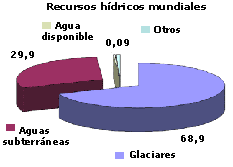 Water is necessary by the development of life as well as numerous human activities. In addition is ascarce resourceso it´snecessary to developsystems that allow the better useof waterexists on our planet. The hydrosphere contains near 1,386 million of km3. The oceans represent ¾ of earth´s surface, and 97.5% of them has a salinity in more of 3% in weight, causing it not suitable for agricultural, industrial or human usages. The rest is fresh water, but 68.9% is in form of ice permanently (impossible to use it) and other available water, near 30% is groundwater and the remainder (0.3%) is found in rivers, lakes, and dams.
Water is necessary by the development of life as well as numerous human activities. In addition is ascarce resourceso it´snecessary to developsystems that allow the better useof waterexists on our planet. The hydrosphere contains near 1,386 million of km3. The oceans represent ¾ of earth´s surface, and 97.5% of them has a salinity in more of 3% in weight, causing it not suitable for agricultural, industrial or human usages. The rest is fresh water, but 68.9% is in form of ice permanently (impossible to use it) and other available water, near 30% is groundwater and the remainder (0.3%) is found in rivers, lakes, and dams.
Another very important consideration in the water distribution of the planet is that not all are available, and not have the necessary quality. At the moment, 26 countries of the world suffer water shortages (300 million), and the forecast for 2050 is that 66 countries suffer this shortage.
In Spain a total o 22.77 million of m3 by year are consumed, and of these, 1554 are destined to the industrial consumption, 17.681,3 to agrarian sector, an d3.535,70 to the urban supplying. As it can be observed the grater number corresponds to the agricultural sector becoming one of the main water plaintiffs. Source: National Institute ofStatitstic (http://www.ine.es)
It is estimated that approximately 80% of fresh water is consumedin agriculture, mainly irrigation.Significant amountsof waterare consumed inthe industrial field,mainly in the productionof energy....
Due to the hydric resources are limited, the technologies based on the desalination of the seawater and the remote water pumping, can palliate the water demand that exists at the moment, but this by itself is not the solution.In addition to thesetechnologies,itis necessary the good water management, preventinglosses orwastagethat existfor example, inirrigationpipes, or obsolete supply networks, by inappropriatemaintenance.Also, it is necessary a recycling system and water reusability as much in agriculture as in the industry where the demand of water so is high.
The water saving is necessary in all the sectors of irrigation consumption, using technical that avoid wastefulness, saving in the domestic consumption and its later purification and reusability.
However, there are arid or isolated areas in the planet that need of external sources of water by their development as desalination. The desalination is a process that allows increase those resources, but has the disadvantage of being an expensive technology and it is not available to all the countries.
The use of desalination techniques, of brackish resources and of seawater, constitutes in certain circumstances a solution to the systematic shortage of hydric resources in some areas.In Spain the water desalination at the moment reaches around 220 hm3/year, of which 127 hm3/year corresponds to the desalination of brackish water and 93 hm3/year to seawater. (Ministry of Environment, 2000). Of the total of water desalted, a 72% are used for urban and industrial use and the rest for irrigation. The development of desalination techniques, especially those that require a smaller power consumption and greater efficiency, have contributed to improve the performance of desalination operations at a lower cost of production, which has affected to consider the desalinated water as an alternative.
Desalination is a separation process of salts from an aqueous dissolution, but can be extended to the separation process of the salt water, because there are technologies that make this process and the main objective to persecute is the separation of both components for human use.
The hydric resources susceptible of desalination can have basically two origins: seawater or salty groundwater; these waters can come from coastal aquifers in direct contact with the sea or can come from of isolated aquifers.
At the moment, don´t exist in Spain, an inventory of geologic structures that store salty waters that are susceptible to exploitation.The availability of thisinformation could solve some of the water shortages in certain areas.The extraction of brackish waters in an aquifer, can give serious problems of deterioration without a sufficient knowledge of the same, and without a suitable programming of pumpings. This case can occur in aquifers connected or not connected to the sea: an extractions poorly planned can increase the process of saline dissolutions, or the uncontrolled advance of the interface.
More information: J.A. López Geta, M. Mejías Moreno. LAS AGUAS SALOBRES. UNA ALTERNATIVA AL ABASTECIMIENTO EN REGIONES SEMIÁRIDAS. Club del Agua, julio 2000 (http://www.igme.es/internet/web_aguas/igme/publica/pdfs/artycon21.pdf)
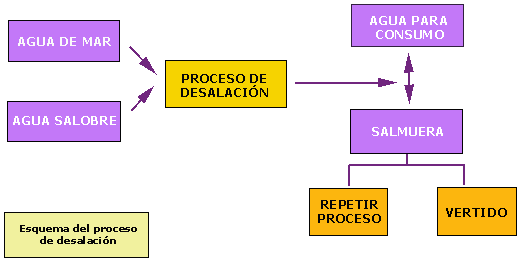
Scheme of the desalination process
The physical system of sea salts elimination or distillation and condensation successive were known from the antiquity, but it implied a very high consumption of energy that made it economically unviable. In more recent dates new technologies have been developed to obtain fresh water (content in salts inferior to 500 ppm) from seawater (content in salts about 35,000 ppm) with a high cost but progressively decreasing, that can be assumed by certain uses. In the last decade has been able to reduce the threshold of 60 cent of Euro (100 ptas/m3).
The technical processes of seawater or brackish desalination can be divided in:
- Distillation Process: are divided into:
- Thermal distillation: the necessary energy for the desalination is obtained from fossil combustibles (coal, natural gas, petroleum, etc)
- Vapor compression: uses anadiabatic compressor which gets two areas of different pressure, generating a vapor flow from the area of higher pressure and condensing temperature, to the inferior, where condensation occurs.
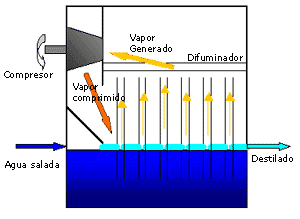
Diagram of the steam compression (CB) with evaporator of vertical tubes (VTE). Source: “La desalación como alternativa al PHN. 2001”
- Solar distillation:adapted for small communities in arid or semiarid regions. It has two variants depending if the sun energy is used directly or is captured by solar cells.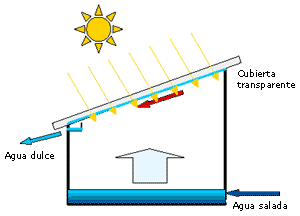
Scheme of a solar collector for distillation. Source: “La desalación como alternativa al PHN. 2001”
- Freeze: the saline water is put under diverse cooling systems and then is evaporated for low pressure in a crystallizer.Ice crystals mixed with brine crystals are obtained and can be separated by mechanical processes.
- Membrane processes: of great diffusion at present. There are two basic types:
- Reverse osmosis: applying mechanical pressure, the natural osmotic pressure is counteracted and the water flows from the zone with greater concentration of salts to the zone with smaller concentration, to obtain pure water.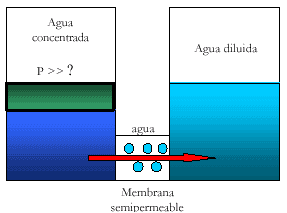
Reverse osmosis processes. Source: “La desalación como alternativa al PHN.2001”
- Electrodialysis: ionic separation through membranes successively located and separated few millimeters. The application of electric fields generates the migration of ions that cross these membranes that act as sieves.
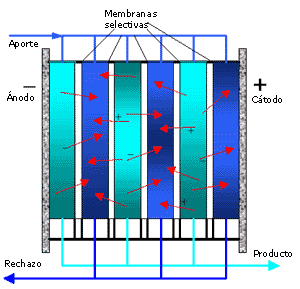
Electrodialysis process: Source: “La desalación como alternativa al PHN.2001”
Desalination techniques: Table
DATES AND NUMBERS OF DESALINATION IN SPAIN
Evolution of desalination in Spain:
- 1964 Lanzarote. MSF
- 1970. Las Palmas I . 20.000 m3/day. Dual plant. MSF
- 1972 Lanzarote. C.V.
- 1976 O.I. in brackish waterfor agriculture. Fuerteventura
- 1980. Las Palmas II. M.S.F. Plant of 18.000 m3/day
- 1984. Lanzarote 500 m3. Reverse osmosis in seawater
- 1986. Lanzarote II. O.I. Plant of 7.500 m3/day to seawater, with hollow fiber membranes
- 1986. Maspalomas. 20.000 m3/day. EDR
- 1990 Las Palmas III. O.I. Plant of 36.000 m3/day
- 1993. Cabo de Gata. First installation of O.I., for seawater in the Peninsula
- 1996. Desalination plant of Costa del Sol. 45.000 m3/day. Hollow fibermembranes
- 1996-98 Desalination plant of Sureste. 7 membranes by tube.25.000 m3/day
- 1998-2000 . Desalination plant of Adeje Arona. 20.000 m3/day
- 1999. Desalination plant of Bahía de Palma .45.000 m3/day
- 2000. Desalination plant of Las Palmas – Telde 37.000 m3/day MED
Source: José Antonio Medina San Juan. "La desalación en España. Situación actual y previsiones".
International Conference: “El Plan Hidrológico Nacional y la Gestión Sostenible del Agua. Aspectos Medioambientales, reutilización y desalación”.
In Spain exist morethan 700 desalination plants.
The installed capacity in Spain is higher to the 800,000 m3/day of which:
Seawater Desalination: 47,1 %
Brackish water desalination: 52,9 %
Desalination plant of seawater with more of 600m3/day of capacity:
4 Desalination plants of more than 20.000 m3/day
23 Desalination plants between 2000 and 5000 m3/day
45 Desalination plants between 600 and 5000 m3/day
72 Desalination plants of seawater of more than 600 m3/day
Great desalination plants in Spain
In operation:
Las Palmas III | 58.000 m3/day |
Bahía de Palma | 53.000 m3/day |
Costa del Sol Occidental | 45.000 m3/day |
(Source: José Antonio Medina San Juan. "La desalación del siglo XXI. Una aproximación a los costes reales de la desalación de aguas salobres y de mar en la agricultura." II National Congress of AEDyR. Alicante 2.001)
The size of the plant, has an influence by the economy of scale that is obtained and therefore with the amortization.
| Costs of investment | ||
| . | Seawater | Brackish water |
| Size m3/day | ptas/m3.day | ptas/m3.day |
| <500 | . | 45.000 |
| 500-1.000 | . | 38.000 |
| 1.000-1.500 | . | 34.000 |
| 1.500-2.000 | . | 29.000 |
| >2.000 | . | 25.000 |
| >5.000 | 160.000 | . |
| 5.000-10.000 | 142.500 | . |
| 10.000-25.000 | 125.000 | . |
| 25.000-40.000 | 110.000 | . |
| 40.000-60.000 | 101.750 | . |
| 60.000-80.000 | 98.000 | . |
| 80.000-100.000 | 87.500 | . |
| > 100.000 | 84.250 | . |
For the amortization of the investments is necessary to consider periods of time and consider if it is an investment in civil works or in equipment, because the investments and the amortization periods are different. Budget
| Budget | ||
| . | Seawater | Brackish water |
| Civil work | 20% | 10% |
| Equipment | 80% | 90% |
Annual interest rate
| Amortizations | ||
| Seawater | Brackish water | |
| Civil work | 30 years | 20 years |
| Equipment | 15 years | 10 years |
| . | ptas/m3 | ptas/m3 |
| Annual interest rate 4% | 20,1 a 38,2 | 2,3 a 4,2 |
| 5% | 21,7 a 41,2 | 2,4 a 4,4 |
| 6% | 23,3 a 44,3 | 2,5 a 4,6 |
| 7% | 25 a 47,5 | 2,7 a 4,9 |
Operation costs
Is necessary to consider two aspects:
1. Power consumption
2. Tariff
These twoaspects are considered in the following table: catchment
| Energy costs of desalinated water | |||||||
| Brackish water | |||||||
| Well depth | Catchment | Increase of salinity | Transfer | R.O | Total | Price of kwh | Total cost |
| Mts | Kwh/m3 | Kwh/m3 | Kwh/m3 | Kwh/m3 | Kwh/m3 | ptas | Kwh/m3 |
| 50 | 0,2260 | 0,2 | 0,2571 | 1,1000 | 1,7832 | 11 | 19,62 |
| 75 | 0,3390 | 0,2 | 0,2571 | 1,1000 | 1,8962 | 11 | 20,85 |
| 100 | 0,4521 | 0,2 | 0,2571 | 1,1000 | 2,0092 | 11 | 22,10 |
| 125 | 0,5651 | 0,2 | 0,2571 | 1,1000 | 2,1222 | 11 | 23,34 |
| 150 | 0,6781 | 0,2 | 0,2571 | 1,1000 | 2,3352 | 11 | 25,69 |
| 175 | 0,7911 | 0,2 | 0,2571 | 1,1000 | 2,3482 | 11 | 25,83 |
| Seawater | |||||||
| . | 0,4 | 3 | 3,4 | 7 | 23,80 | ||
In the table the operation data have not been considered
"The main limiting factor for the use of the desalination is almost exclusively economic.
At the moment, we can say taht the cost of seawater desalination marks the threshold at which we can obtain the resource in coastal areas, which will influence decisively on the study of the various alternatives to solve the shortfalls.
It is necessary to add that the cost of the desalted water has been decreasin significantly in the last years, as a result of the power cost reduction (main component of the cost of desalted water) and of the technological improvements and the markets development.
The energy costs always suppose between the 50 and 75% of the operation ral costs, reason why the possible increase of the desalination is very directly linked with the cost of the energy, which tends to be stable or to go to the loss in the last years.
Furthermore, the reduction of the cost in the water desalinated will facilitate the expansion, and will be able to serve as an important technological advance in the development of these process.
IIn our country, the forecast of desalination increase in short and mid term, considering the works in phase of construction and those of next execution, would elevate the present date in more than 400hm3/year. Figure 371 of the White Book of the Water"
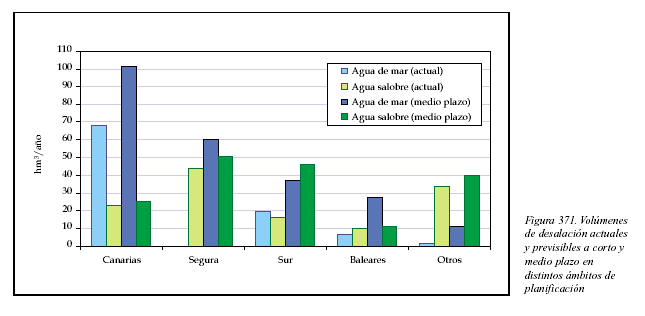
Current and foreseeable volumes in short and medium term in different areas
(Source: Esperança Gacia y Enric Ballesteros. "El impacto de las plantas desalinizadoras sobre el medio marino: la salmuera en las comunidades bentónicas mediterráneas".)
There are two basic processes by which salt is extracted from water: distillation and reverse osmosis.
The impact that these processes have in the marine environment is similar and is due mainly to the discharge of wastewater, although there is some impact from the process of water catchment.
The waste waters obtained of desalination process have a higher salt content that the origin waters. This waters present differences of temperature, pH, alkalinity and contain chemicals substances used during the purification process.In the case of the plants that work by distillation, the spill represents from 8 to 10 times the volume of water purified and in plants of inverse osmosis the residual volume is less than the previous (from 2,5 to 3 times of polished volume) but the spill has a content in salts higher.
In both cases is necessary to add the chemical agent spill (biocides, anti-foulingand anti-foaming) result of the water treatment, and the others spills resulting from the cleaning of the membranes.Traditionally the chemical impact of the reverse osmosis process has been considered despicable by spill at very low concentrations (Morton ET to. 1996).However many discharges (table) have an impact on the marine environment and, in some cases (ej metals) by the burden that represents.
Compounds | Origin/Function | Impact |
Heavy Metals: Cu, Fe, Ni, Cr, Zn | corrosion | accumulation in the system, stress at molecular and cellular level |
Phosphates | anti-fouling | macronutrient, eutrophication |
BELGARD'2000 (Ac. Malic) | anti-fouling | unknown |
Cl- | anti-fouling | formation of halogenated compounds, carcinogens and mutagens |
Fatty acids | surfactants | cellular membranes |
Sodium Sulfide | anticorrosive, captures O2 | unknown |
Sulfuric acid | anti-fouling | in great amounts decrease the pH of the system |
Solid residues | membrane cleaning | turbidity |
Brine | seawater concentrate | variable |
Temperature | treatment | variable |
Recomendations:
Location in areas where the impact on benthic communities is minimal (preferably poured into funds without vegetation).
- Avoid enclosed bays with important ecological value (ej. marine angiosperms)
- The discharge ofbrine must be located in areas with medium or high hydrodynamics to facilitate the dispersion of the salt.
- Avoid important changes in the hydrodynamic regime that may affect to the sedimentation processes and try to the water has good quality to minimize the posterior chemical treatment.
- Investigate different aspects of the impact of brine in the littoral
- Studies of environmental impact of each element separately are needed
- Real Decreto Legislativo 1/2001, de 20 de julio, por el que se aprueba el texto refundido de la Ley de Aguas. Access to full text
- Real Decreto 1327/1995, de 28 de julio, sobre las instalaciones de desalación de agua marina o salobre. Access to full text
- Ley 54/1997, de 27 noviembre, del Sector Eléctrico. (Vigente hasta el 1 de enero de 2002). Access to full text
- Ley 12/1990, de 26 de Julio, de Aguas (BOCA nº 94, de 27.07.90)M.A.: 1990/1927. Access to full text
- Corrección de errores de la Ley 12/1990, de 26 de julio de aguas. Access to full text
RD 1138/1990 European Directive 80/778/CEE (Source: Millarium.com).
The decree divides the parameters in:
- Organoleptic
- Physico-chemical
- Nondesirable substances
- Toxic
- Microbiological
- Radioactivity
The specific section by desalted waters pays attention in three parameters:
- pH: must be balance so that the water is not aggressive
- Alkalinity: must have at least 30 mg/l de HCO3 - .
- Hardness: at least 60 mg/l of Ca ++.
includes a series of parameters divided in three parts:
- Microbiologic
- Chemical
- Indicadors (guide values)
According to the Water Law:
Continental waters: the continental brackish waters are part of the Hydraulic Public Dominion ant the desalination of this type of waters is put under the regime of the Water Law (TRLA) and needs the previous authorization (Art. 13 del TRLA).
Seawater: this activity can be done by any physical or legal person without concession or authorization in matter of Hydraulic Dominion, but it´s necessary to have others authorizations by possible spills (Art.13 TRLA).
- Rico Amorós, Antonio M.; Olcina Cantos, Jorge; Paños Callado, Vicente; Baños Castiñeira, Carlos. Depuración, desalación y reutilización de aguas en España (estudio regional).Barcelona: Oikos-Tau, 1998.
- II Congreso Nacional Aedyr. "La Desalación y Reutilización del Siglo XXI". Alicante, 21-22 november 2001.[CD]
- Valero, Antonio; Uche, Javier; Serra, Luis. La desalación como alternativa al Plan Hidrológico Nacional. Aragón. [On line]. http://circe.cps.unizar.es/spanish/isgwes/spain/desala.html
- López Geta, J.A.; Mejías Moreno, M.. Las aguas salobres. Una alternativa al abastecimiento en regiones semiáridas. Los acuíferos costeros y las desaladoras. Almería, 2000. [On line]. http://www.igme.es/internet/web_aguas/igme/publica/art_2linea_5.htm
- Medina, José Antonio. La desalación en España. Situación actual y perspectivas. Conferencia internacional el Plan Hidrológico Nacional y la Gestión Sostenible del Agua. aspectos medioambientales, reutilización y desalación.
- Naredo, José Manuel. La gestión del agua en España. Problemas y perspectivas. Conferencia internacional el Plan Hidrológico Nacional y la Gestión Sostenible del Agua. aspectos medioambientales, reutilización y desalación.
- Wangnick, Klaus. Visión general de tecnologías de desalación y perspectivas.Conferencia internacional el Plan Hidrológico Nacional y la Gestión Sostenible del Agua. aspectos medioambientales, reutilización y desalación.
- Libro Blanco del Agua. Ministerio de Medio ambiente, 2000. [On line]. Libro Blanco del Agua
- Esperança Gacia y Enric Ballesteros. "El impacto de las plantas desalinizadoras sobre el medio marino: la salmuera en las comunidades bentónicas mediterráneas".
Documents:
- Conferencia internacional el Plan Hidrológico Nacional y la Gestión Sostenible del Agua. aspectos medioambientales, reutilización y desalación
- "Desalación"
- "Desalación del agua mediante energías renovables"
- "Desalación de aguas mediante energía geotérmica"
- "Procedimiento para la utilización ecológica, turística o minero medicinal de las salmueras procedentes de plantas salinizadoras"
- "Desalination: Present and Future"
Associations
Events
- Conference on "Membranes in Drinking Water and Industrial Water Production". Mulheim (Germany): 22 - 26 september 2002. Organized by the International Water Association (IWA), European Desalination Society (EDS), American Water Works Association (AWWA) and Japan Water Works Association (JWWA)
- Pre-treatment and Post-treatment Technologies in Desalination. 5ª Annual Conference. Haifa (Israel): 3 - 4 december 2002. Organized by Israel Deslination Society
- Water & Wastewater Europe. Niza (Francia): 4 - 6 de march 2003.
- EDS Conference Desalination and the Environment. Malta: 4 - 8 may 2003.
- Desalination Strategies in South Mediterranean Countries. Morocco, 3 - 6 may 2004.
July 2002




